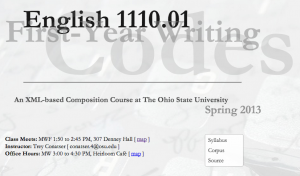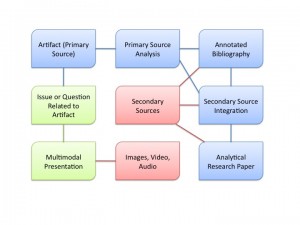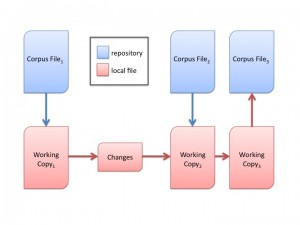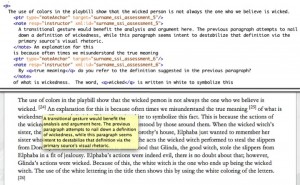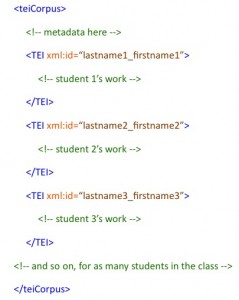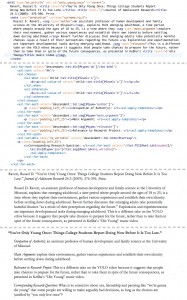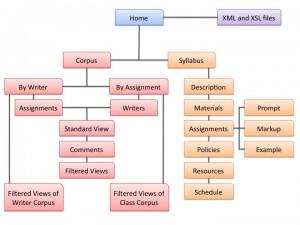Changing Medium, Transforming Composition
Trey Conatser
Knowing only that they had registered for a first-year writing course, my Spring 2013 students walked into the first class meeting to discover that they had signed up for “Codes: An XML-based Composition Course” (Figure 1). Although most at the time weren’t familiar with extensible markup language or even its acronym (XML), all could infer its nature as some kind of coding language. Popular media often represent code as profoundly illegible to the point that one can “read” it only as an aesthetic object (think of the vertical crush of green symbols that ostensibly constitute the virtual world in the Matrix franchise). My course, however, argued that XML facilitates hyper legibility in the writing class. XML is a deeply rhetorical language, and it presents an opportunity to teach writing as a metacognitive, iterative, and collaborative process.
Composition scholars are increasingly calling our attention to “the new models of composing developing right in front of our eyes.” They argue that writing in the 21st century is immersive, collaborative, and participatory; the writing class, then, should reflect these values and engage students with a variety of digital media.[1] Composing videos, crafting audio essays, and analyzing social media profiles represent new and exciting ways of taking up what compositionist J. Elizabeth Clark calls “The Digital Imperative,” but what about the text-based assignments that seem hopelessly old-fashioned in the face of such multimodality? My course intervenes at this point in the scholarly discourse with the conviction that the textual mode of composition and, in particular, the academic essay, remain viable and valuable ways of preparing students for writing in the 21st century.
First-year writing courses at Ohio State require students to complete a sequence of four analytical writing assignments and a PechaKucha-style presentation based on an artifact of the student’s choice (Figure 2). Students most often choose to analyze the rhetoric of advertisements, film and television scenes and trailers, brief texts or excerpts of texts, songs, music videos, images, user interfaces, websites, and buildings. After selecting their artifacts, students compose (1) a primary source analysis that develops analytical claims and research questions that will yield compelling insights, (2) an annotated bibliography that establishes the relevance of a selection of secondary sources in pursuit of those research questions, (3) a secondary source integration that revises the primary source analysis with insights from and in response to the secondary sources from the annotated bibliography, and (4) an analytical research paper that substantiates an original claim about the artifact’s rhetorical significance.
My course retained this framework of assignments but changed the medium of composition from word processing programs to <oXygen/>, an XML editor. In spite of the proliferation of software programs, the word processor with its digital representation of an 8.5-inch by 11-inch sheet of white paper overwhelmingly remains the preferred medium and default user interface for composition. This course decoupled mode from medium, the word from the processor. XML is a descriptive markup language, meaning that XML tags for the most part describe what they enclose (“what is this?”) and don’t tell software what to do (“how should this look on a screen?”). For each assignment I specified a markup scheme in line with its most urgent goals. Requiring students to compose and tag their writing within an XML editor ensured that they explicitly and deliberately identified their own rhetorical and compositional choices.
XML inherently promotes metacognition because it requires writers to enclose portions of their text in descriptive tags. XML can be broken down into three pieces: the element, the attribute, and the attribute value. Enclosing content in descriptive tags structured like Russian dolls, one inside the other inside the other (ordered hierarchy of content objects or OHCO is the technical term for this protocol), writers have the freedom to name any part of their composition anything that they want, as many times as they want to name it. In Figure 3, for example, a segment element whose type attribute carries a value of “ev_interp” contains two segment elements whose type attributes carry values of “interpretation” and “evidence.” The medium itself requires writers to compose deliberately, in specific terms regarding the task at hand. Rhetorically-oriented markup schemes make assignment goals explicit in a way that traditional prompts simply can not; they provide consistent opportunities during the writing process to reflect critically on whether the composition is successfully working toward the assigned goals.
To make the writing process iterative, collaborative, and participatory my students worked on a single “corpus” file housed in a version control repository. The 24 students in my class composed every assignment on an XML file that, by the end of the semester, reached over 42,000 lines in length and was edited over 1,300 times. In addition to the major assignments — primary source analysis, annotated bibliography, secondary source integration, analytical research paper — the corpus file also included daily assignments, notes, comments, and links to non-textual objects such as images and PowerPoint presentations.[2] When students began a work session they first opened the editing software’s built-in SVN (subversion) client, from which they retrieved the most current version of the working copy from the repository. After editing the file, perhaps adding new material or revising work they had already done, they once again updated their working copy to the most current version from the repository (to reflect any changes made after their initial update) and “committed” the local file as the newest version of the corpus (Figure 4).
Requiring all students to update a single file reinforced the writing process as iterative and granular because each commit or editing session represented a focused and discrete task (Figure 5). Rather than the word processor’s blank page and blinking cursor, students saw the SVN client’s accretive commit log. The intellectually paralyzing proposition of producing a finished (or even finish-able) piece of writing in a single sitting dissolved in the solution of manageable tasks; completing an assignment seemed like a sculptor shaping stone, not a magician conjuring the statue.
More importantly, the corpus’s radical transparency made everyone’s work visible to their colleagues, encouraging collaborative learning and providing an embodied and immediate audience: the holy grail of writing classes. Otherwise ephemeral and private marginalia such as peer and instructor comments become a lasting and public part of the corpus file and its HTML output (Figure 6), tracing a more complete model of writing and research processes.[3] Students consulted the class corpus both informally and with specific questions or problems in mind: for example, surveying how others approached a particular assignment, or getting a sense of how the instructor responded to others’ assignments. The more information available to students, the more they were empowered to take command of their work.
The visibility of commit records piling up in the SVN history log also revealed how ideas and arguments develop incrementally in a public forum. Whereas Kathleen Fitzpatrick suggests a dichotomy between “editorial and curatorial labor” and “the production of new texts,” the transparency of the corpus file encouraged students to conceive of the former as a way of approaching the latter.[4] It revealed the production of new texts as labor — the putting-together and modification of ideas — as opposed to the divine conception that students anxiously associate with isolated production. The root node <teiCorpus> contained all material in the corpus file, and child <TEI> nodes with “@xml:id” attribute values of “surname_firstname” contained each student’s unique work. For comments in a colleague’s <TEI> element we used <note> elements with “@resp” (responsibility) attributes whose values matched the commenters’ <TEI> “@xml:id” attribute values (Figure 7). The corpus format reified authorship as the attribution of intellectual work and property to individuals (“who did what?”) but it also emphasized authorship as visible, participatory, and deliberate: as public-a(c)tion.
Viewing work as we’re used to seeing it on the printed page allows a limited range of reflection; the ability to filter and rearrange tagged content further bolsters the metacognition inherent in XML composition. Because XML does not tell a computer what to do, an additional language (extensible stylesheet language or XSL) was required to “transform” the corpus into browser-readable HTML, and some basic jQuery UI widgets and effects made the output instructively dynamic. Along with XML, then, XSL facilitates rhetorical analysis and metacognition.[5]
XSL transformations (XSLT) allow students to view their texts not only as discrete entities but also as filtered compilations (with attributions) of all approaches to specific tasks. For the first-day writing exercise, students could filter the corpus to hone in on everyone’s previous writing experiences, important reading experiences, initial thoughts on the course theme and format, or expectations for their classwork. In this case, XSLT allowed students to see how their colleagues responded to specific aspects of the assignment prompt, and they also began to think about their work not as an undifferentiated blob of text but as a complex rhetorical mechanism that attempts to perform several tasks simultaneously.
Comparing students’ work, however, represents only one aspect of XSL’s flexibility. For the primary source analysis, students viewed interpretive statements about their artifacts in connection with the descriptive statements that they tagged as evidence for those specific interpretations. By filtering out the rhetorical “noise” of the text in its entirety, students were able to fine-tune specific aspects of their work (Figure 9). Lastly, file links in the XML translate to embedded objects in the browser user interface, presenting nonlinguistic items (images, videos, audio), which writing instructors historically have treated as ancillary to and disconnected from orthographic composition, as integral to the rhetorical situation. Only the XML markup scheme limits the possibilities of XSLT, and I’ve included the markup scheme for each major assignment as an appendix.
One may question if markup actually expands our metacognitive repertoire, or if it’s just the latest way of standardizing the writing process. Requiring students to follow a markup scheme risks teaching writing as a formulaic process (or, to take it one step further, as a digital incarnation of the infamously inflexible five-paragraph essay). The solution is to privilege rhetorical markup over structural markup. Each assignment’s scheme told students what to tag, but not where to tag it. For the analytical research paper, students tagged considerations of the artifact’s medium, but this could happen anywhere in the assignment, as many or as few times as needed. With such freedom came serious consideration of why one had chosen to arrange a composition in a particular way. “Form, not formula” became a battle cry. Far from simplifying the writing process into a fill-in-the-blank exercise, markup-based composition deftly integrates the active reflection on formal choices as long as the markup scheme privileges rhetorical concepts.
Student feedback confirmed the metacognitive benefits of composing in XML. “I had to deliberately think about how I was writing, not just what I was writing,” one student remarked. “The tags, at first, were a pain because they made me rewrite many sentences but once I understood their purpose, they helped focus my thoughts so that at the end of the papers I accomplished my goal.” In course evaluations students reported that composing in XML according to specific markup schemes led them to think critically about what they were doing and why they were doing it. Just as importantly, they appreciated and learned from the corpus’s transparency, which led them to approach classwork and class meetings as collaborative efforts. “The most surprising affordance from the format was being able to see my classmates’ work,” the same student explained. “I could read their work to gather ideas about what to write about and learn from everyone’s different styles of writing.” Lastly, students considered all assignments and compositions as working in concert to realize course goals because the corpus file preserved and centralized every effort, from the granular and ephemeral to the holistic and sustained. As another student commented, “It was also very cool to see how the topic manifested from a single source to a whole body of work.”[6]
Based on my use of XML in the freshman composition classroom, I found that markup, especially XML, promotes metacognition and collaboration in ways that merit further exploration in teaching and scholarship. My class met and exceeded the goals of the First-Year Writing Program at Ohio State, but I’m not content to make such a localized argument. The XML- and corpus-based writing class merits adoption as a standard course offering at any postsecondary institution. With such growth in mind, I offer the following reflections and recommendations:
- I used <oXygen/> because I was familiar with it, but there may be better XML editors for teaching composition and rhetorical analysis. I explicitly set out not to teach programming, and I chose XML because of its proximity to natural language and its emphasis on description over procedure. <oXygen/> requires writers to follow Text Encoding Initiative guidelines, which distance XML from “natural” description for the sake of standardization. This obviously helps scholars and editors who want to produce electronic texts that will be legible to other scholars and editors, but the primary audience for the class corpus is the class itself. For a writing class, the tag <evidence> is more pedagogically useful than the TEI-compliant tag <seg type=”evidence”>.
- Creating and teaching the course is time-intensive for a single writing instructor. I taught myself XSLT, HTML, CSS, and Javascript as the course went along, learning primarily from free tutorials, message boards, and trial-and-error. As a post-coursework, pre-dissertation graduate student I was able to commit to such a time investment (only for the one semester, and at great cost to my exam reading), but an instructor with other professional responsibilities couldn’t have spared the time and energy. Were a department to offer the course, the browser-side programming would need to be developed beforehand, and ideally by professional programmers, so that instructors could focus exclusively on the XML corpus file. Tweaking extant XSL based on specific needs is a thimble-full of water compared to the ocean of composing XSL from scratch. I insist that instructors need to retain the ability to modify the stylesheets in order to preserve students’ ability to determine how they want to see their work; otherwise, we risk forcing all course sections into a “one size fits all” metacognitive model.
- Students need a comprehensive and multimodal set of tutorials. Narrated screen-capture videos would have worked much better than the textual instructions that I distributed at the beginning of the semester. Again, time presents a barrier; the tutorials would need to be available to the instructor and not by the instructor. Class meetings are a precious resource that shouldn’t be squandered on recurring technical or procedural problems. My class as a whole did not internalize the commit protocols for the subversion repository, and especially when major due dates loomed students accidentally erased each other’s work. Restoring lost material from previous versions isn’t impossible or even difficult, but it becomes tedious and time consuming when multiple users forget to update their working copies before committing to the repository. Those who followed the protocols became frustrated when others’ mistakes affected their own work, and this speaks to the degree of accountability that the corpus format instilled.
- The XML-based writing course should be listed as such in course catalogs. My effort was isolated and without precedent; thus, it appeared in the catalog as a standard first-year writing section. Scheduling classes is often a house of cards for undergraduates, and we shouldn’t assume that they have the freedom to switch sections if the format proves unproductively challenging or alienating.
Code.org is running a well-publicized campaign to make computer science and programming a universal educational opportunity, while commentators hail coding as “the new second language.”[7] Careerist pragmatism has a well-documented history of provoking unease among humanities scholars, and Peg Tyre’s term “second language” implies an entirely new array of literacies that instructors must address in addition to those for which they’re already responsible. In the writing class, however, code need not be considered a second language, a supplement to the “real” work to be done, nor the death knell of the embattled “life of the mind.” As digital humanities scholar Matthew Kirschenbaum notes, code is “a unique and startling way of looking at the world…in fact, a kind of world-making.”[8]
The XML-based writing class treats code as a startling way of thinking and making. It transforms a medium originally adopted (by humanities scholars) for the transcription of extant texts into a medium for the composition of new texts. The metacognition and collaboration that it promotes are a way of practicing not only writing, but also humanities in the 21st century.
Originally published by Trey Conatser on April 18, 2013 and revised for the Journal of Digital Humanities August 2013.
The markup scheme for each major assignment can be found in the Code Appendix for this article.
I am indebted first and foremost to Dr. H Louie Ulman, Director of Digital Media Studies and Associate Professor of English at The Ohio State University. Dr. Ulman’s graduate course in electronic textual editing spurred my interest in XML, and he generously served as an adviser (and promoter) for all my efforts in preparing and teaching “Codes.” I’m also grateful for the support of Dr. Edgar Singleton, Director of First-Year Writing at Ohio State, who indulged a first-year GTA’s desire to bite off what very well could have been more than he was able to chew. Software developers Mike Conley and Will Smelser provided valuable insight and troubleshooting, especially regarding XSLT, HTML, CSS, and Javascript. The most credit, however, goes to the 24 students who bravely stuck with me all semester long and emerged as part of the avant-garde of a changing educational landscape. Without their thoughtful and diligent efforts the class wouldn’t have been such a transformative experience. This article originated as a talk for “CODE: Codified Objects Define Evolution,” a panel sponsored by the Digital Arts and Humanities Working Group at The Ohio State University on March 18, 2013. The script became a blog post for the Humanities, Arts, Science, and Technology Advanced Collaboratory (HASTAC), which was featured as a Digital Humanities Now Editors’ Choice for April 2013.
- [1]Kathleen Blake Yancey, “Writing in the 21st Century,” National Council of Teachers of English (Feb. 2009): 7, http://www.ncte.org/library/NCTEFiles/Press/Yancey_final.pdf (quotation); J. Elizabeth Clark, “The Digital Imperative: Making the Case for a 21st-Century Pedagogy,” Computers and Composition 27 (2010): 28.↩
- [2]Because files stored via Google Code are publicly accessible and freely searchable, I used Assembla, which provides free, private storage so that student information would remain confidential (we used names as unique identifiers).↩
- [3]All communication pertaining to grades, of course, remained a private matter between each student and the instructor.↩
- [4]Kathleen Fitzpatrick, Planned Obsolescence: Publishing, Technology, and the Future of the Academy (New York: New York University Press, 2011), 78-80.↩
- [5]I wrote the XSL files and didn’t make them available to students, not for a desire to exercise authority but as a fulfillment of my initial promise that the course would in no way involve procedural programming. It’s useful for writing students to think about how they want to view their work with respect to tagged content, but considering the rhetoric and writing course’s goals, it’s not useful to task students with learning XSL’s comparatively restrictive lexicon and syntax. The XML-based writing class is not a programming class.↩
- [6]Student feedback forms in author’s possession.↩
- [7]Peg Tyre, “Is Coding the New Second Language?” Smithsonian Magazine, May 24, 2013, http://www.smithsonianmag.com/ideas-innovations/Is-Coding-the-New-Second-Language-208882061.html.↩
- [8]Matthew Kirschenbaum, “Hello Worlds: Why Humanities Students Should Learn to Program,” The Chronicle of Higher Education, Jan. 23, 2009, http://chronicle.com/article/Hello-Worlds/5476.↩

